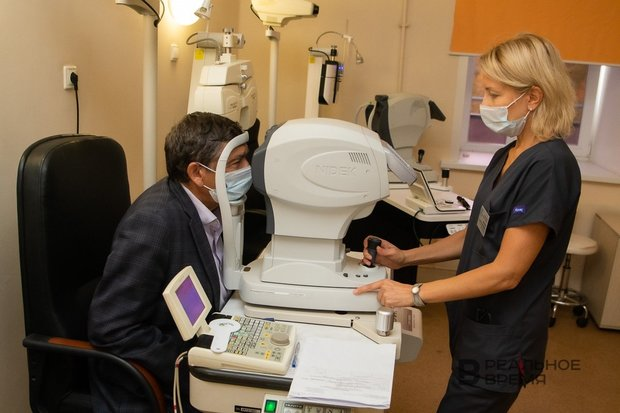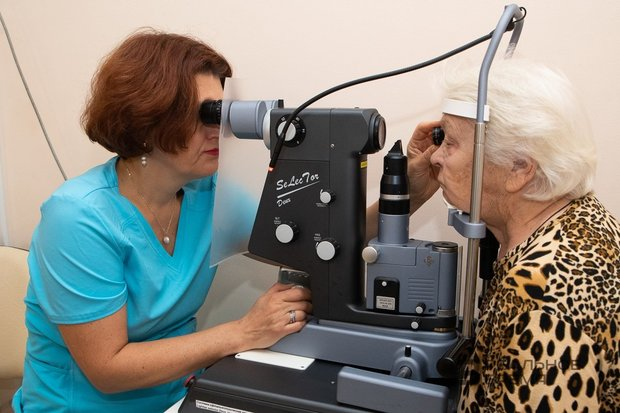Tatarstan learns how to stop the development of glaucoma
World Sight Day was yesterday, and ophthalmologists draw the attention of Tatarstan citizens to a rise in diseases leading to blindness, especially among young and able-bodied citizens. At the moment we see that we unlikely fully understand what it means to go blind. But we are so afraid of going blind and even slight eye floaters cause serious anxiety among us. Meanwhile, there is an eye disease leading to blindness that is impossible to be diagnosed without a special examination when there is still hope. And this disease is widely spread today. Read about insidious glaucoma, new possibilities of the Republican Clinical Ophthalmological Hospital and specialists’ recommendations for those who want to keep their eyes in good health in Realnoe Vremya’s report.
Not to remove the “dead” eye
A glaucoma office opened in the polyclinic of the Republican Clinical Ophthalmological Hospital (RCOH) where Tatarstan residents who suffer from glaucoma, ocular hypertension and those who have just been suspected to have glaucoma are consulted. The significance of this event is hard to overestimate: according to the Tatarstan Ministry of Health, nearly 33,000 people suffer from glaucoma in the republic.
Patients are received in the glaucoma office of the polyclinic of the ocular hypertension with a referral of ophthalmologists from polyclinics for free, via the mandatory medical insurance. As Realnoe Vremya was said in the clinic, all patients going to this office will be added to the republican registry of patients with glaucoma.
“People are concerned because of dry eyes caused by a long use of gadgets or something else, go to see the doctor complaining for discomfort, express their fears of losing the sight, and often this has nothing to do with any serious disease,” says vice chief doctor of the RCOH, chief visiting ophthalmologist of the Health Care Office of Kazan Yelena Zhidenko. “While glaucoma sneaks up asymptomatically first causes irreversible changes and can lead to blindness. The patient feels nothing at early stages. The case is complicated because glaucoma is treated but not cured — the process of sight loss can be slowed down, suspend but not turn back. The sight cannot be recovered because irreversible changes happen in the eye as a consequence of ocular pressure and fibres of the ocular nerve gradually die.”

A conservative medicine-based therapy and surgery — both laser and surgical methods — are offered to treat glaucoma as well as many other pathologies.
“Nowadays the Adamyuk Republican Clinical Ophthalmological Hospital we can offer our patients the full range of diagnostic and surgical methods,” says Yelena Zhidenko. “Diode cyclophotocoagulation that allows influencing the amount of intraocular fluid — to suppress its production and activate its discharge — appeared in our clinic in late 2020. Earlier, in terminal glaucoma when the eye doesn’t see anymore and sometimes really hurts, we could offer the patient only to remove the eyes, enucleation. Now we have an alternative to this surgery — diode cyclophotocoagulation. As a result of this intervention, the sight isn’t recovered but the pressure goes down and the pain subsides, the eye doesn’t need to be removed, purely an aesthetic problem is solved and the patient doesn’t have to buy an eye prosthesis, care about it... If glaucoma is detected at an earlier stage, the sight loss can be suspended, and sometimes it can even stopped with micropulse cyclophotocoagulation. The micropulse treatment can be repeated if needed from time to time, thus maintaining the patient’s quality of life.
According to Yelena Zhidenko, since the equipment for such surgeries appeared in the RCOH, the number of enucleations suddenly has plunged in Tatarstan: 67 surgeries in 2019, 39 in 2020, only 29 in 2021:
“It is impossible to refuse them completely, but glaucoma is no longer an absolute indicator for enucleation, for instance, for cancer. At the same time, the number of cyclophotocoagulations, by the way which are available for patients via mandatory medical insurance, also grows rapidly: in 2020, 20 surgeries were done, 110 — in 2021, 194 since early 2022, and the year has not ended yet.
Invisible enemy of sight
In answer to the question about the signs one can learn about developing glaucoma before it becomes a “sentence”, Yelena Zhidenko made a helpless gesture:
“There are not any signs. Glaucoma develops invisible for a very long time. A person cannot see some objects because of defects in the eye sight and do not suspect this. The person either doesn’t attention to it or the brain shows the full picture — there are no black spots in front the eyes. This is why it is necessary to have your sight checked, measure the intraocular pressure and examine the fundus of the eye from a certain age. Not in optic salons in a hurry when prescribing glasses but in a clinic, it is necessary to do a thorough examination.
According to the chief visiting ophthalmologist of the Health Care Office of Kazan, high intraocular pressure is the main factor leading to the development and progress of glaucoma. Research shows that the risk of developing glaucoma is also related to heredity.
“If you didn’t have relatives who have had glaucoma, who have gone blind for any reason, it is necessary to get examined by an ophthalmologist once a year after 40 years. If you did, it is necessary to get examined from 35.

Risk factors
Diseases such as diabetes, atherosclerosis, hypertension, blood clotting problem, high intracranial pressure, moderate and high myopia and thin eye cornea are key risk factors besides heredity and high intraocular pressure.
“A thin eye cornea is seen more often now, many have it as a consequence of laser sight correction,” noted Yelena Zhidenko.
“”Does it mean that laser sight correction shouldn’t be done so that the cornea doesn’t get thin?” Realnoe Vremya asked.
“No, of course. Correction methods constantly improve. For instance, now absolutely different interventions are carried out compared to the 70-80s, and absolutely safe surgeries are done if indicated.”
“What are the signs one can suspect glaucoma is developing? To put it simply, when it is necessary to up and rush to get examined?” Realnoe Vremya’s corresponded wondered.
“If you have noticed all of a sudden that you have foggy eyes in the morning, if you see rainbow circles when looking at the source of light, if you feel pain in the eye pit for no reason, see an ophthalmologist immediately. In general, the first rule is not to wait for any first signs but annually do a check-up after 35-40 years.”
No need to rush but it is important not to be late
“It has been proven that a 30% fall in intraocular pressure reduces the progress of glaucoma by 70%,” head of the polyclinic of the RCOH Olga Zvereva confirmed her colleague’s correctness. “And the earlier glaucoma is diagnosed, the more chances of saving nerve fibres in the eye, which means, the sight.”

However, she stressed, the treatment of the disease that has been diagnosed starts not with the most invasive methods but on the contrary, with mild ones, first of all, with medication:
“It turns out to be effective in 90-97% of cases. It is just necessary to understand that medicines don’t cure the disease but just reduce the intraocular pressure for some period of time — from 8 to 12 hours, this is why eye drops should be used with such an interval. And one should keep in mind that all medicines have a side effect — from a local reaction, redness and even swelling to cardiovascular complications. And in these cases there is sense in turning to laser surgery and cyclophotocoagulation.”
Also, Olga Zvereva complained that trabeculoplasty, which is effective for glaucoma and considered to be a high-tech treatment method, was much more available just a few years ago: RCOH ophthalmologists had the equipment in their offices and a doctor could make a decision to do the procedure during an appointment.
“It is valuable because it can be done immediately if needed. Now according to the Russian Health Care Ministry’s decision, it is done at outpatient clinics like before, via mandatory medical insurance. But it can be several weeks between the appointment with the ophthalmologist and surgery, the proper moment can be missed, and other more invasive treatment methods will be needed.

When examination doesn’t show the full picture
Also, Olga Zvereva reminded us that glaucoma, which is the first and main cause of sight disability in Russia, is a socially important disease:
“Glaucoma is identified at late stages — in stages two and three. These are serious stages when a patient already has serious irreversible consequences of the disease. Therefore the population’s screening plan was included an examination helping to diagnose glaucoma. But unfortunately, such an examination is not always enough to correctly make a diagnosis because only the intraocular pressure is measured during the screening, and the doctor looks at the general norm when evaluating the result, not an individual one.

She indicated another important moment:
“Statistically, women suffer from glaucoma more often. But such statistics come from the data on patients’ examinations. And women are examined more often — men in our society didn’t get used to complain and visit doctors. This is why we can assume that the real amount of people suffering from glaucoma doesn’t really depend on the sex of patients.
Everybody has one’s own norm
Olga Zvereva put an example of a female patient who turned out to have allergy to literally all medicines after seven years of treating the disease:
“She could use the drops only for two weeks. To stop the progress of glaucoma, selective trabeculoplasty was applied — it is laser treatment of the cells in the zone located in the front corner of the eye responsible for the discharge of intraocular fluid from the anterior chamber of the eye ball. We have repeated this surgery three times when the intraocular pressure went up with time. And only then we resorted to micropulse cyclophotocoagulation. In the end the intraocular pressure was lowered to the target figure and it hasn’t grown in the last 1,5 years, but if needed the procedure can be repeated.”
Olga Zvereva also talked about an atypical development of glaucoma, therefore it is the hardest to diagnose and dangerous too:
“The intraocular pressure must be from 16 to 25 mmHg. But every person has one’s own norm within this range. Research has shown that the pressure of 16-18 mmHg is a norm for 20% of people, 19-20 mmHg is a norm for 70%, and 23-25 mmHg is for just 7%. A patient turned to us who had the intraocular pressure within the norm — 25 mmHg, she was referred from the polyclinic for examination with the diagnosis of Stage 1 glaucoma. It turned out she had developed glaucoma a long time ago, doctors just related the sight loss to her cataract. During a thorough examination, we found out that her intraocular pressure is a way above her personal norm — 25 instead of 18. She was lucky, the diagnosis was made when medication turned out to be effective. However, if needed, we will use other treatment methods too.”